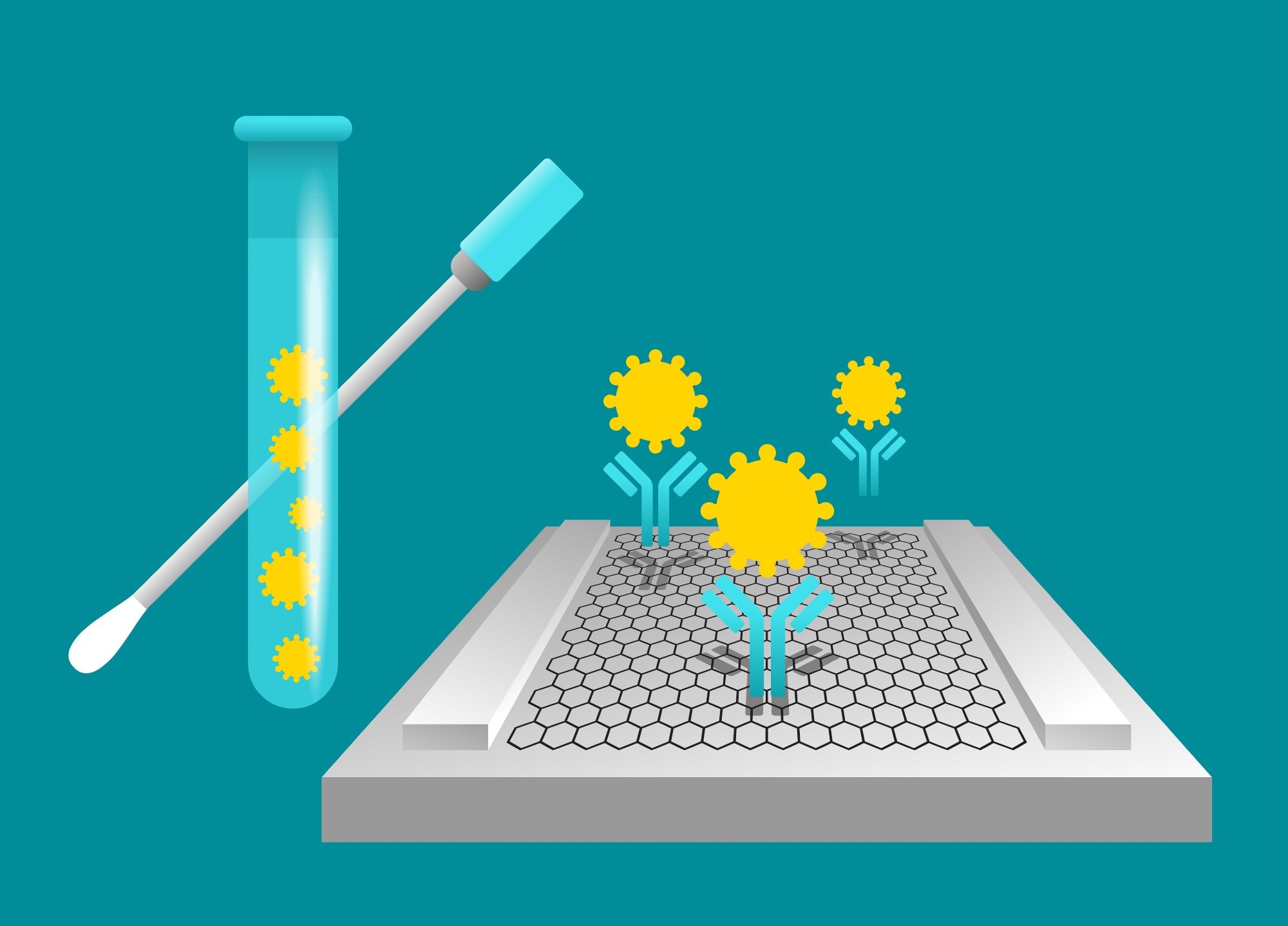In a recent study posted to the medRxiv* preprint server, researchers developed an antibody (Ab)-modified graphene field effect transistor (GFET)-based biosensor for ultraprecise and rapid influenza A virus (IAV) and severe acute respiratory syndrome coronavirus 2 (SARS-CoV-2) protein detection and differentiation.
 Study: Graphene Field Effect Biosensor For Concurrent And Specific Detection Of SARS-CoV-2 And Influenza. Image Credit: Dmitry Kovalchuk/Shutterstock
Study: Graphene Field Effect Biosensor For Concurrent And Specific Detection Of SARS-CoV-2 And Influenza. Image Credit: Dmitry Kovalchuk/Shutterstock

 *Important notice: medRxiv publishes preliminary scientific reports that are not peer-reviewed and, therefore, should not be regarded as conclusive, guide clinical practice/health-related behavior, or treated as established information.
*Important notice: medRxiv publishes preliminary scientific reports that are not peer-reviewed and, therefore, should not be regarded as conclusive, guide clinical practice/health-related behavior, or treated as established information.
Background
The coronavirus disease 2019 (COVID-19) pandemic has underscored the need for novel, point-of-care diagnostic devices that can rapidly detect and differentiate viruses that, although cause infections with identical physiological symptoms, require specific and targeted therapies. SARS-CoV-2 infections could exacerbate IAV infections, elevating the global healthcare burden.
Reverse transcription polymerase chain reaction (RT-PCR) analysis is the current gold standard for viral detection. However, the United States (US) Centers for Disease Control and Prevention (CDC) has reported that RT-PCR is not suitable for identifying early respiratory virus infections, with long duration of analysis and sample transport requirements to well-equipped laboratories.
About the study
In the present study, researchers developed an Ab-modified GFET sensor for simultaneous IAV and SARS-CoV-2 and IAV detection in an ultraprecise and rapid manner.
The sensor chip comprised four GFETs in a quadruple arrangement, separated by polydimethylsiloxane (PDMS) enclosures. Every quarter was biochemically functionalized with SARS-CoV-2 and IAV antigen-targeted Abs, one chemically passivated control, and one bare control.
The third (chemically passivated) GFET was deployed to ensure that the results observed were due to Ab-antigen interaction rather than electronic fluctuations or drifts.
The inner PDMS enclosure was shorter than the outer one to enable independent biochemical functionalization for every GFET while enabling GFETs to act via a shared gate and medium. An Ag/AgCl (silver/silver chloride) pellet-type electrode was submerged in the common medium to function as a gate electrode.
PBASE (1- pyrenebutanoic acid succinimidyl ester) was incubated on a graphene surface for targeted immobilization, and PEG-NH2 was used as a blocking reagent to ensure reaction specificity. PBASE immobilization on graphene was evaluated by electrical characterization and Raman spectroscopy.
The CR3022 Ab targeting SARS-CoV-2 spike (S) protein receptor-binding domain (RBD) and the FI6v3 engineered Ab binding to the IAV hemagglutinin (HA) protein were used for SARS-CoV-2 and IAV detection, respectively.
The antigen-Ab interactions depended on uniform viral diffusion in low-strength (0.01X) phosphate buffer solution electrolyte, with the EDL (electric double layer) of four to 15 nm generated at the graphene-electrolyte site serving as a double-electric layer. The user was required to add only one drop of viral surface protein solution onto the sensor device. The biosensor platform was tested against several concentrations of viral proteins, and viral protein (antigen)-Ab interactions were validated by enzyme-linked immunosorbent assay (ELISA) assays.
A test analysis was performed using BSA (bovine serum albumin) as a control analyte to evaluate device specificity. To evaluate the device sensing ability, time trace measurements were performed wherein all GFET transistors were subjected to varying concentrations of SARS-CoV-2 S and IAV HA proteins at different time intervals. The voltage range between 120mV and 200mV showed the greatest transconductance and, thus, was chosen for the sensor to ensure maximal sensitivity.
Results
The biosensor design enabled isolated and targeted biochemical graphene channel functionalization with a common medium for analyte introduction and subsequent translation into a change in Ab-modified GFET conductance.
The team observed a 1623 cm-1 peak post-graphene functionalization with PBASE in Raman spectroscopy, concomitant with pyrene resonance, and hole doping (peak right shift) and right shift of the CNP (charge neutrality point) and I2D/IG reduction from 2.9 to 1.2 in the electrical characterization analysis. The findings indicated PBASE attachment on the graphene surface. The NHS (N-hydroxy succinimide) ester in PBASE reacted with primary amines of viral proteins, enabling Ab immobilization.
The Abs tested were viral antigen-targeted with negligible cross-reactivity. The GFET biosensor turnaround time was only 10 seconds, enabling swift and specific diagnosis. The biosensor performance could enable the diagnosis of early viral infections. CR3022 could bind to SARS-CoV-2 variants such as Delta and Omicron, and FI6v3 could bind to all type 1 and 2 IAV subtypes, indicative of a wide diagnostic breadth of the biosensor.
Using low-strength phosphate buffers, voltage and PEG-NH2 in functionalization yielded very high sensor sensitivity, with a superior resolution for detecting analytes at very low protein concentrations. The lowest effective protein concentrations (limit of detection, LoD) of SARS-CoV-2 and IAV proteins were 88 zM and 227 zM, respectively, lower than previously used platforms by five-fold.
Overall, the study findings highlighted using an Ab-modified GEFT-based biosensor for swift, ultraprecise, sensitive, specific, and cost-effective detection of diverse SARS-CoV-2 variants and IAV subtypes. The versatile biosensor LoD surpassed the minimal LoD needs of 163 fM and 16 aM for nasal and saliva samples, respectively, potentially decreasing the time required for test administration post-viral exposure.

 *Important notice: medRxiv publishes preliminary scientific reports that are not peer-reviewed and, therefore, should not be regarded as conclusive, guide clinical practice/health-related behavior, or treated as established information.
*Important notice: medRxiv publishes preliminary scientific reports that are not peer-reviewed and, therefore, should not be regarded as conclusive, guide clinical practice/health-related behavior, or treated as established information.